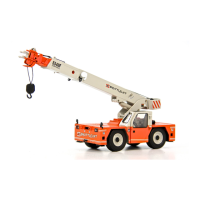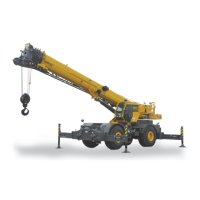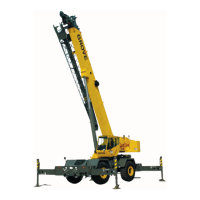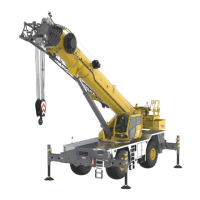OPERATING PROCEDURES TMS9000-2 OPERATOR MANUAL
4-72
Published 02-21-2019, Control # 611-05
be moved to the left to retract the boom, and it would be
moved to the right to extend the boom (while keeping in mind
that only one boom section - the boom section the
telescoping cylinder is locked to - would be moving).
As highlighted in a previous note in this document, these
arrows (1, Figure 4-140), at some point in the telescoping
process, will blink. The blinking is an indication that an
unlocking or locking event will occur if the operator holds the
joystick in the direction of that arrow for at least 1 second. If
this event begins, then the screen will change to the dots (as
described for Figure 4-139) so that the operator knows that
an automated motion or action is again occurring.
The RCL must be configured and activated in order to have
automated motions or to have operator control of the
telescoping function. If the Enter Rigging Mode screen on
the RCL display is used (accessed with the '?' icon on the
RCL display), then the telescoping action is paused. When
the check-mark is used on the RCL display to re-activate the
RCL, then the telescoping action resumes (whether
automated motion or operator control).
As seen in Figure 4-140, there are sets of numerical values
at the top portion of the screen above the graphical
schematic of the boom.
First, there is a set of values in a top row with values of 1 to 5
in circles (2). The 1 to 5 in the circles indicate the telescoping
boom sections (or “tele sections”). The 1 is for the boom
section that is the largest and closest to the base section.
This is referred to as T1. This then proceeds from T2 to T5
for the 2 to 5 values.
The values under these boom section indication numbers
represent the requested final boom configuration (or “target
tele picture”). Figure 4-140 shows this set of values as 100-
100-0-0-0 (3). This means that T1 is to be extended to its
100% pinning location, T2 is to be extended to its 100%
pinning location, and the remaining boom sections remain at
their fully retracted, 0%, pinning locations. It is vital that the
operator understand that this requested final boom
configuration is the first step in operating the pinned boom in
the Semi-auto Mode. Everything the control system performs
with the Semi-auto Mode is dependent on this requested
final boom configuration.
Second, there is a set of percentage values shown under the
requested final boom configuration values. In Figure 4-140,
these are shown as 100%-100%-0%-0%-0% (4). This
represents the control system's currently computed actual
boom configuration (or “actual tele picture”). This can be
understood as what the boom likes “now” (but as mentioned
above the operator must be aware of the physical boom to
compare to these values). As the boom is operated this
computed boom configuration will change (just as the
schematic graphic for the boom system will change on the
display). But the operator should realize that the requested
final boom configuration will not be changing as the boom is
operated (it is the final destination for the boom motion).
Third, there is a list of percentages on the left (0%, 50%,
92%, 100%) (5). These percentages are the available
pinning locations for the boom sections. They represent an
extent of the distance along the next larger boom section
where the boom section can be pinned - i.e. locked to the
next larger and encompassing boom section. The 100% is
not the extreme end of the next larger boom section, but the
farthest available pinning location (there will always be some
overlap between boom sections). The list of percentages are
command buttons in the control system interface; a value
can be highlighted, and then an Enter button used to actually
select the value in the list. When an Enter button is used in
this manner, it sets all the values for the boom sections for
the requested final boom configuration to that value. For
example, if Enter is used on the 50% button, then all the
values in the top row of the display will be set to 50 (thus
requesting the final boom configuration of 50-50-50-50-50).
Semi-auto Mode basic operating procedures
The following steps would be expected for extending the
boom in Semi-auto Mode:
• Enter the Semi-auto screen on the operating display.
The icon for this screen is (1) Figure 4-141.
